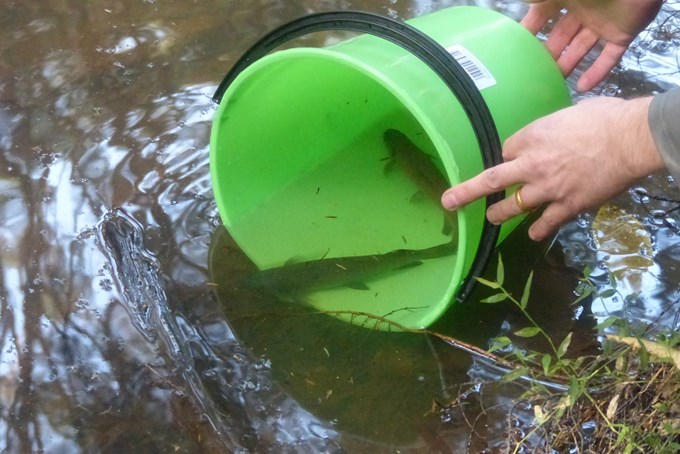New Zealand’s largest and rarest whitebait species received a helping hand re-establishing in the wild last weekend when reinforcements arrived in the Waikokohai and Mangatawhiri streams in Tāwharanui Regional Park. 140 adult fish were released into the two streams to entice at least some of the 10,000 "all at sea" fingerlings released last year, to return to their tribe for spawning.
Giant kōkopu disappeared from Tāwharanui around 30 years ago following the construction of a dam to create a pond in the lower reaches of Waikokowhai Stream. But restoration efforts since have seen it returned to an environment that scientists believe can now provide the habitat they need to thrive.
Reintroducing whitebait
The joint project between Auckland Council, Manāki, Ngati Manuhiri and NIWA follows the release last year of 10,000 juveniles in two of the park’s main waterways – the largest reintroduction of whitebait in New Zealand.
Manāki fish breeder Paul Decker says what the average consumer of a whitebait fritter doesn’t know is that whitebait can grow up to 2.5kg as adult fish and live for 30 years.
“While the fertilised eggs can only develop in fresh water, once hatched the fry of these five native fish species immediately get swept out to sea, grow into whitebait and return to spawn up rivers and streams,” Decker says.
But if the juveniles can’t sense the pheromones of their own species they will not bother to travel back up those streams, which is one of the reasons why whitebait catches have been declining in the wild. As adult populations are destroyed inland, more fresh water courses are not seeing the whitebait runs they once had.
Efforts by the council to unearth giant kōkopu populations has reinforced just how rare the species has become in Auckland. A handful of “new” populations have recently been uncovered by members of the public but giant kōkopu have all but disappeared from their former habitats.
Auckland Council senior ranger Matt Maitland says much needs to be done to create a future for the species in the region.
“The reintroduction of giant kōkopu to the Tāwharanui streams is of significant conservation value to the region,” he says.
“The integration of farming and public recreation within the pest-free sanctuary provides opportunities to restore the whole ecosystem, allowing us to return this rare and threatened species alongside takahē, kiwi and saddlebacks.”
Manāki, a commercial breeder of whitebait for sale and export, has supplied the fish for this project and implanted tags for ongoing monitoring by NIWA.
NIWA principal scientist Dr Cindy Baker and staff have installed antennae at the dam exit, in the dam itself and in the stream that feeds into the dam, that will pick up the movements of the giant kōkopu.
“We want to understand how fish use the environment – how much time they’re spending in the dam, compared to in the stream, whether they’re adapting to this habitat or whether they leave the system,” Dr Baker said.
“There are already similar species such as eels and banded kōkopu living happily in the water which suggests to us that perhaps the giants, which also breathe through their skin, could survive as well,” Dr Baker said.







